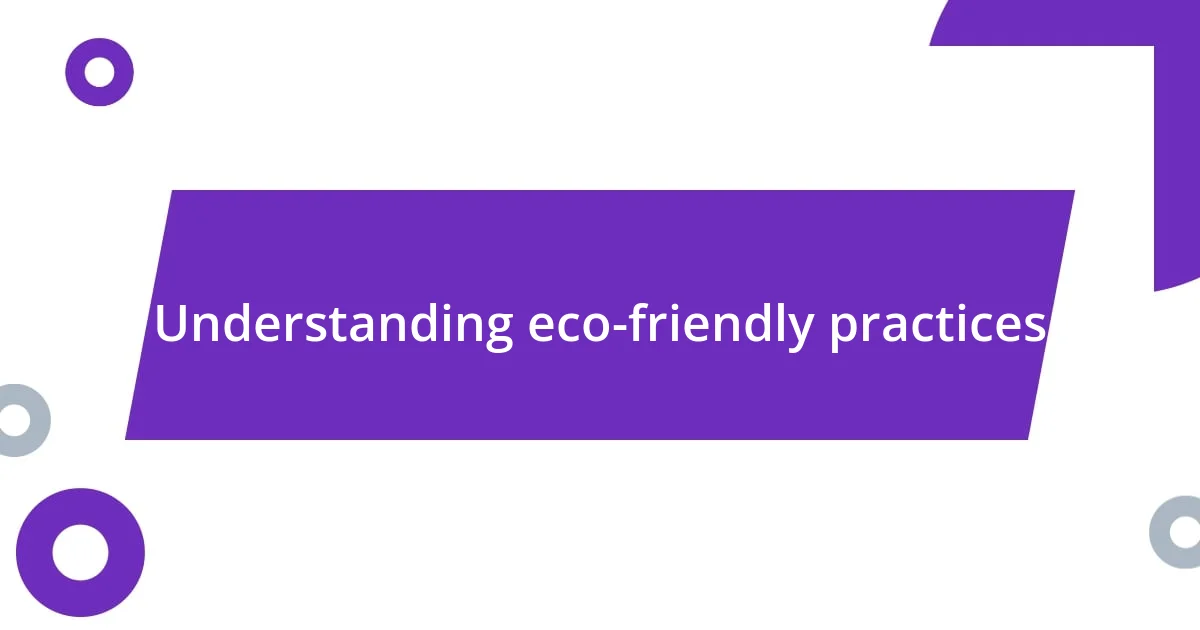Key takeaways:
- Eco-friendly practices encompass a lifestyle shift, emphasizing mindfulness in consumption and community support, such as choosing local produce.
- Effective teaching methods for sustainability include hands-on experiences, visual aids, and discussion groups that foster personal connections and engagement.
- Measuring success in eco-education involves tracking tangible outcomes, gathering participant feedback, and observing long-term community impact through personal stories and behavior changes.

Understanding eco-friendly practices
Understanding eco-friendly practices goes beyond just recycling or using reusable bags; it’s about adopting a lifestyle that respects and nurtures our planet. I remember the first time I swapped out traditional cleaning products for homemade solutions—what a revelation! Not only did my home feel fresher, but I also felt empowered knowing I was reducing chemical waste. How many small changes can we make that accumulate into significant impacts?
I often find myself asking others, “What does it mean to live sustainably?” It’s a question worth pondering because each person’s answer can shape their habits and choices. For me, it’s all about mindfulness in consumption. I’ve started favoring local produce at my farmer’s market, which not only supports community farmers but also cuts down on transportation emissions. How has shopping local changed the way you view sustainability?
On a personal note, I once tried to explain eco-friendly practices to a friend who seemed indifferent. I shared my experience of transforming a small backyard into a thriving garden. Watching those plants grow and produce food was grounding and fulfilling. I’ve learned that sometimes, engaging others with relatable, tangible experiences can spark a real interest in eco-friendly living. Isn’t it amazing how personal stories can inspire change?

Benefits of eco-friendly education
When I reflect on the benefits of eco-friendly education, I realize that it nurtures a sense of responsibility. It empowers individuals to make informed decisions that not only enhance their lives but also protect the environment. I vividly recall a workshop I attended where participants shared their eco-friendly journeys. Hearing their stories inspired me to push the envelope in my own sustainable practices.
Here are some key benefits I’ve observed from promoting eco-friendly education:
- Increased Awareness: People become more conscious of their environmental footprints.
- Community Building: Eco-education fosters a sense of belonging among like-minded individuals.
- Health Benefits: Adopting greener habits often leads to a healthier lifestyle, both physically and mentally.
- Economic Savings: Learning about sustainability can help individuals and families save money through energy conservation and responsible spending.
- Empowerment to Act: Equipped with knowledge, individuals feel more motivated to advocate for environmental policies.
Overall, it’s a rewarding experience to witness how knowledge transforms both mindset and behavior. Each small step towards sustainability creates a ripple effect, influencing others in ways we cannot always measure.

Effective teaching methods for sustainability
- When teaching sustainability, I’ve found that hands-on experiences often resonate the most. One time, I organized a community clean-up event, and the energy was contagious! Participants were not just cleaning up; they were connecting with each other and the environment. It’s fascinating how actively engaging people in the cause can inspire them to adopt sustainable habits long after the event ends.
- Visual aids are another effective method I use to teach eco-friendly practices. I remember once creating a colorful infographic that illustrated the journey of a plastic bottle from production to disposal. That simple visual made the broader issue of plastic waste feel personal and immediate for my audience. Seeing complex topics broken down in relatable ways can often lead to those lightbulb moments for others.
- Discussion groups also prove beneficial for sustainability education. In one gathering, I prompted a conversation about renewable energy options. Hearing varied perspectives and personal stories brought the topic to life. It’s amazing how much knowledge and inspiration can flow from open dialogues, fueling motivation to embrace sustainable choices.
| Teaching Method | Description |
|---|---|
| Hands-on Experiences | Engaging participants through active involvement in sustainability projects. |
| Visual Aids | Using infographics and visuals to simplify complex sustainability issues. |
| Discussion Groups | Facilitating open conversations to share ideas and personal stories regarding eco-friendly practices. |

Creating engaging workshops on sustainability
Creating workshops that truly engage participants in sustainability can be a game-changer. For instance, on one occasion, I decided to incorporate storytelling into my workshop. Instead of just lecturing about climate change, I invited attendees to share their personal experiences with nature and how they were affected by environmental issues. This approach turned out to be incredibly powerful; it transformed my session from a one-sided exchange into a vibrant conversation brimming with passion and personal connection.
I also believe that integrating art into sustainability workshops can lead to remarkable outcomes. One time, I hosted a community art project where participants created magnificent sculptures from recycled materials. Watching their creativity blossom as they turned discarded items into inspiring pieces was a joy. It was a visual reminder of what we can accomplish when we think outside the box. How often do you think we underestimate the power of creativity in driving home a message?
Lastly, I’ve learned to prioritize interactivity in my workshops over traditional lecture formats. When I introduced eco-challenges—simple daily tasks that encouraged participants to adopt sustainable habits—I noticed a marked shift in their enthusiasm. For example, we set a week-long challenge to reduce single-use plastics, and each evening we gathered to share our successes and struggles. This weekly check-in fostered a sense of accountability and camaraderie that I had never anticipated. Isn’t it fascinating how shared experiences can deepen commitment to sustainability?

Utilizing social media for outreach
Harnessing social media has become an essential part of my outreach efforts in promoting eco-friendly practices. I remember when I started a dedicated Instagram page focused solely on sustainability tips. The moment I posted a simple DIY project using recycled materials, I was amazed at how quickly people began sharing their own creations. It’s incredible how a single post can catapult engagement and inspire others to get creative with sustainability!
I’ve also discovered the power of storytelling through social media. One time, I shared a heartfelt video of my journey toward a zero-waste lifestyle. The flood of comments from viewers sharing their struggles and triumphs was both moving and motivating for me. Isn’t it interesting how personal stories can forge connections that drive collective action? It reminds me that we are all in this together, working toward a common goal.
On platforms like Facebook, I regularly host live Q&A sessions where I tackle burning questions about eco-friendly habits. I still recall a lively session where attendees asked about composting tips, and we ended up sharing local resources and even setting up a community composting initiative. Those moments of collaboration showcase the power of social media to transform virtual connections into real-world actions that make a difference. Have you considered how your own digital presence can help drive sustainability?

Developing community partnerships for impact
When I think about developing community partnerships for impact, I recall my collaboration with a local farmers’ market. I proposed a sustainability day, where vendors shared their eco-friendly practices and we organized workshops on composting right there at the market. The buzz around the event was palpable, and seeing the community come together to embrace an eco-conscious lifestyle was incredibly rewarding. Isn’t it fascinating how a simple idea can ignite such enthusiasm?
Another memorable experience was partnering with nearby schools to create a “Green Schools Initiative.” We worked together to implement recycling and energy-saving projects while empowering students to take the lead. The energy during our brainstorming sessions was electric, as the kids came up with innovative plans like a school-wide “Waste-Free Lunch Day.” Watching them take ownership filled me with hope and reminded me that our future lies in their hands. Have you ever witnessed young minds revolutionizing long-held practices?
I’ve also found immense value in joining forces with local environmental organizations. One particular collaboration involved conducting community clean-up days, which not only beautified our neighborhoods but also strengthened friendships among participants. The camaraderie during those events fostered a sense of accountability that extended beyond our cleanup efforts. Each time we gathered, I couldn’t help but think about the ripple effect we were creating together. Isn’t it inspiring to realize that collective action amplifies our individual efforts?

Measuring success in eco-education
Measuring success in eco-education often requires tangible outcomes alongside personal reflections. I remember tracking the reduction in waste generated by participants in a workshop I facilitated on sustainable living. The joy I felt when one participant shared that they’d cut their household waste by nearly half in just a few months was unforgettable. How do you quantify inspiration, anyway? Sometimes, it’s simply in the stories that people share.
Another way I assess success is through feedback surveys after my sessions. One time, I was pleasantly surprised to find that over 90% of attendees felt motivated to adopt eco-friendly practices. I can still picture their eager faces as they engaged in discussions about composting and sustainable shopping tips. It showed me that knowledge alone isn’t enough; it’s the personal connection and enthusiasm we cultivate that truly makes a difference.
I also find that measuring community impact can be as rewarding as individual success stories. I often engage with participants long after an event, checking in to see how they’re implementing eco-friendly practices at home. A recent chat with a neighbor revealed her new habit of biking to work instead of driving. Hearing her enthusiasm for this small yet impactful change reminded me that our efforts ripple outward, creating a larger wave of eco-consciousness. Doesn’t it feel good to know that every conversation can spark a change?














